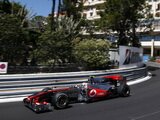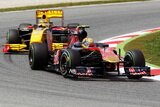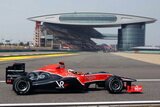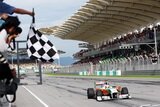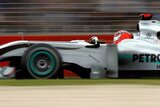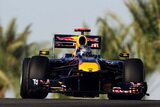Q: Ross, things seem to be better for you?
Ross Brawn: So far, but we have often had good Fridays and then found the rest of the weekend more difficult. But the car is not too bad. We are trying to consolidate more with a couple of the changes we have made over the last couple of races and get the maximum from them this weekend as opposed to adding a lot of new stuff. It is a consolidation weekend. Drivers are reasonably happy today. The car seemed quite respectable on high fuel, but a bit tricky out there later on with the gusts. We saw a lot of cars going off. The gusty wind was making it a bit edgy for the drivers but not too bad.
Q: Christian?
Christian Horner: Well, it is great to be back at Silverstone and firstly on a Friday to see so many people here is fantastic. With the changes to the circuit we were a little concerned that it would take a bit away from the character of the track, but it seems to have worked pretty well. There are a couple of bumps that are a bit tricky, but I think it still offers a big challenge to the drivers. They seem to enjoy the circuit, the new element of the circuit. We have run through a pretty standard programme to here, both drivers testing different aspects, both seem pretty happy and for Silverstone... I was amazed today to see track temperature at 40 degrees, something that you wouldn’t usually expect to see. A pretty positive day. We had an issue with Mark’s (Webber)... an electrical issue on Mark’s car at the end of the day, nothing major. He got a little bit of down-time at the end for Mark but overall pretty happy with the way the day has gone.
Q: Martin?
Martin Whitmarsh: I think a difficult day for us really. A new package. I think we have got to do a lot of learning. I think we have some useful information. We have now to turn that information into a way in which we can make the car quicker tomorrow. Really exploring the car. I wouldn’t say a lot of the time that the drivers were comfortable, but we were learning and we will take that data and see what we can do this evening.
Q: How important is this event as a home race. You are all based in the UK, but some of you also have bases elsewhere.
TF: I think it is very important. It is where it all started for me. I met Mike Gascoyne here a year ago. I feel as though I have been in Formula One for 100 years, but it was only one year ago that the first idea came out. Of course it is great for the team to be back here. It is great to see a Lotus car back at Silverstone, so it is important. Hopefully we can deliver something to be worthy of the Lotus name. It has been a fantastic start for us, but expectations grow and grow and grow. Let’s hope we can bring two cars home. We have had lots and lots of emails, lots and lots of people saying they are coming. In Snetterton the other day we had 22,000 people turn up. That was quite an eye-opener for me and many of them said they are going to be here on Sunday, so let’s hope that we can give a performance that’s worthy of the name and the support that we are getting.
RB: Very meaningful race for me. It is a circuit where when I was working with Frank Williams, Frank won his first grand prix with Clay Regazzoni, so it has got some very fond memories and it is nice to be at a race that some of our staff can enjoy. We are based here but we are very multi-national. We have four home grands prix as we have Britain, Hockenheim, Abu Dhabi and with Petronas we have Malaysia, so we are fortunate that we have four races with extra pressure.
Q: Christian, an Austrian team but based down the road in Milton Keynes.
CH: It’s our local grand prix and this weekend we have pretty much all the factory coming up over the course of the weekend. It is the one time that they get to see the cars in action. It is fantastic to be back at Silverstone. We all thought that perhaps last year might be the last year but it is great the work Damon Hill has done with the BRDC to secure the future of the British Grand Prix here at Silverstone. I think it is one of the circuits that is still amongst the favourites of the drivers. It still offers a massive challenge, an adrenalin rush for the drivers to compete around here. I think it is important that we retain the historic events combined with the modern events such as Singapore and Abu Dhabi. It is tremendous to see the turn-out even on a Friday that is here this weekend. It is one of the highlights of the calendar and a race we are keen to run well at.
MW: I think as the guys have said it is great for a lot of people at the factory to be able to come and see the cars and I think that is important. It is very special for that reason. It is a campsite grand prix. It is a grand prix where you are very aware of people who have camped out for three or four days. They are very knowledgeable, very enthusiastic, and you meet them. I think that is quite special and it is something which increasingly we don’t have in Formula One where perhaps we haven’t developed that level of following and that history in some of the new circuits that we go to.
Q: Another question to all of you. What has been your drivers’ reaction to the new circuit? What did they think about it?
TF: The initial thought was they kind of missed the old circuit. But they grew to like it towards the end, what they did run of it. They felt there was a little bit of low grip in the new bits but overall they enjoyed the circuit.
RB: I think they are fine with it. It is not such a dramatic change. There is a bit of an issue with the bumps adjoining the old and new circuit which brings a bit of a challenge but they are fine with it and I think it hasn’t taken anything away from the great character of Silverstone. I am not sure if it has added a lot but it certainly they are pleased with it and there is nothing strange.
CH: I think it is an interesting addition to the track. It puts the track close to six kilometres which is a very long lap now. I think the only thing probably the circuit has given away is Bridge Corner which was a real challenge for the drivers and spectacular to see a grand prix car through there. But it has got a different characteristic, it adds a different dimension to the track. It puts an added emphasis on slow speed performance rather than just high speed predominance and it is another dimension and interesting challenge. The drivers have reasonably enjoyed it. There is a big bump through Abbey that you probably have all seen which is a little bit tricky but it is the same for everyone. Different, not necessarily better or worse, but just different. An added challenge.
MW: I think our guys were spending the day exploring the new car and the set-ups of that, not so much the circuit, so I don’t think I have got anything to add to what has already been said. I think we were trying to understand what we have got here in the way of a car rather than understand the circuit.
Q: Tony, what have been the repercussions as far as you are concerned within the Lotus team after the accident at Valencia? Has anything changed?
TF: No, nothing at all. I am still friendly with Christian and vice-versa. No, nothing at all.
Q: There wasn’t anything that you could have said to the driver?
TF: We were perfectly happy with what Heikki did. He was racing. He braked at the right place. The telemetry said so. That’s just racing.
Q: Ross, you talked about what you hoped was an improved performance here and about the various bits that have gone on the car. Has it been already improving what has gone on the car and really sorting it out, something which I suspect every team has got to do with these blown rear wings, blown diffusers etc.?
RB: I think there is an interesting chemistry to this year. With Christian’s team we have got one team which is setting the standard in terms of pace and we are all trying to catch up and in trying to do that you take jumps but sometimes you fall over and with no testing it is very easy to make a slightly wrong move and the field is so close. I think Nico (Rosberg) in Valencia was six-tenths off the fastest time in Q2, but he didn’t make it to Q3. You get a few things wrong in trying to put your package together, perhaps don’t pay attention to the fundamentals as you are chasing these new features and you can fall away very quickly. I know Christian said this the other day and I always said it at Ferrari. There are no silver bullets. There is no one thing that you turn a switch and you suddenly find a huge amount of lap time. It is an accumulation of smaller things and because they are smaller things they are very often difficult to quantify and know that they are definite improvements. It is pretty challenging this environment of Formula One. But it is the same for all the teams, it is just a different type of challenge now to perhaps the one we had five or 10 years ago and I think it brings to the fore the need for modelling, simulation, driver-in-loop simulators, those sort of facilities which the top teams are building up to substitute for testing.
Q: Martin, the same question to you. You are not at the bottom of the rung but is that what you are experiencing now, particularly with the bits that were brought at half-past-one this morning?
MW: Yeah, I think everyone in the factory is pushing hard and we are bringing the parts here. I think the issue is that often when you are developing the car you are incrementally bringing downforce to the car, the balance of the car. The driving set-up characteristics don’t change dramatically but with the changes that we are evolving all of us on the cars apart from Christian, then it requires a different approach, a different driving style, a different set-up, so in an era where there is not very much testing it is quite difficult to go and nail that. You have a limited number of tyres, fairly limited number of time and laps to do it in. That’s the challenge. That’s the modern era of Formula One and we have got to take all the data we have got today, make some decisions on what we are going to do tomorrow and hopefully get it right.
Q: Christian, do you see everyone getting closer and closer to you? And what does it take with those various bits to then develop them further?
CH: As we all know if you stand still in this business you tend to go backwards. As a team we are working very well. I think we have managed to add performance to the car at every grand prix so far this year and we have got a few little bits here which are helping as well. It is testimony to the effort that is going on in the factory 10 miles or so from here that as a group the extra mile they are going to get the components to the car, the hours that are going in, are just immense. Our performance is very much a team performance. I cannot speak too highly of the effort that is going in at the moment. Inevitably when you are setting the pace you are there to be shot at effectively. People tend to cherry pick bits and pieces or highlight bits of the car that might add performance but at the end of the day as we all know it is the package that counts. The guys have done a great job in evolving that package and the car, for example, here compared to where it was in Bahrain at the beginning of the year is considerably different but we can only focus on our own, getting performance to the car and hopefully that will be enough to keep us towards the front. We must never underestimate the likes of McLaren who have got tremendous heritage and also Ferrari and obviously the other big teams such as Mercedes. It is a very healthy situation for Formula One that there is not one team running away with things at the front of the field.
QUESTIONS FROM THE FLOOR
Q: (Alan Baldwin - Reuters) Martin, this new upgraded package was originally intended for Hockenheim and it’s obviously been a rush to get it here. Perhaps you can give us some more insight as to how much of a last minute rush it has been to get everything done?
MW: As has been described, parts were still arriving at 1.30 a.m. There are a lot of new components on the car. People have worked incredibly long hours and day and night to just get those parts here. I think all of us, from Lotus through to Red Bull, we’re all very proud to be part of organisations that are fighting to improve every fortnight. Formula One is an infectious business. Wherever you are on the grid you want to be one or two places further forward and that produces such commitment from people within our teams that while we are here talking about it, the amount of effort that people put in is phenomenal. It’s a big effort. You’ve not only got to get the components, you’ve got to assemble them onto the car. Mechanics here worked very, very late. I’m sure they’re going to be working through tonight as well as we consolidate those parts, make sure that they’re working, make sure that we have the right specification of car tomorrow. We had a number of different parts on the car here today, we’ve got to try and pick through the data, make sure that we’ve got the best package that we can provide to our drivers tomorrow.
Q: (Tom Clarkson - Tom Clarkson and Associates) Christian, you made a reference there to Bahrain. If you took the RB6 back to Bahrain now, could you put a number on how much quicker it would be?
CH: Very difficult. Usually Murray (Walker) asks the difficult questions. Difficult to say, probably somewhere close to a second, possibly. The pace of development is very high and the thing you never get a chance to do is go backwards. In the current regulations we have to try and rely on our simulation tools, be it wind tunnel or CFD and there are very few components that we’ve put on our car this year which have actually come off. Everything that’s gone onto the car has pretty much added performance. You’ve got to assume that you’re probably looking at around a second between now and Bahrain.
Q: (Bob Bull - BBC Three Counties Radio) You talk about these increments you make each race, the little additions. How do you actually discover what they are and how you need them? To the general members of the public over there it seems a bit strange. Perhaps you could explain why you think or how you think about a modification that improves the car. What’s the process?
RB: The tools we have, which Christian just touched on: we have the wind tunnel, we have simulation tools, modelling tools. We know the factors which make a car go faster. There are some very simple, fundamental factors: if you have more downforce, or you have less drag, or you have a lower centre of gravity; those things normally bring added performance. The challenge for the engineers is that there’s rarely one dimension to any changes you make. There are often two or three dimensions to the effect that it has on the car and trying to unravel those extra dimensions come from added performance or perceived added performance which is very challenging. To give you an example, it’s very easy to make a front wing which is more efficient with more downforce but might be more sensitive to the height it runs at, so on the track, it’s not necessarily a quicker front wing. It’s when you get into that added dimension that it becomes complex and where we need to continue to develop the tools and the assessment methods we use. Years ago we just went out on the track and pounded round, using dozens of sets of tyres, and try to establish the performance gains that way. Now it’s actually quite different. But we all know the things that make a car go faster. Our aerodynamicists know that if they find more downforce, if they find less drag, more efficiency, then the car will go faster. So we’ve got lots of groups of engineers looking at areas and trying to find ways of improving their area. And it’s not just the aerodynamics, it’s the mechanical performance, it’s the structural performance, it’s new materials. Everyone in the company who is responsible for performance is trying to find five per cent, ten per cent every year and it just accumulates into an improved car.
Q: (Mike Doodson) In the good old days, if there had been an incident like the one that we saw in Valencia between Tony’s car and Christian’s, with a bit of luck, we, the journalists would have been rewarded with the two drivers rushing to each others’ pits to punch each others’ lights out. It’s very frustrating to see the two of you being so terribly polite to each other. It was still a bloody great big shunt. I had a disagreement with a colleague of mine about who was to blame. Tony said earlier on that Heikki braked at the correct point. I’m sure that Mark Webber would disagree with that. It also looked to me as though Heikki was dithering. He couldn’t decide whether he was about to be lapped or whether he was racing. Could we perhaps have a little bit more interplay between the two of you, and perhaps some figures about who did brake at what point and whether it was correct or not?
TF: First point is that he (Heikki) wasn’t in any position of being lapped, he was racing. Mark came out of the pits and Heikki was ahead of him and he was racing for his position. So there was no dithering at all, he kept his line, he was straight on his line and according to our telemetry, he braked exactly at the right place, so we hold him at no responsibility at all.
CH: I spoke with Heikki this morning and I said to him that it might be a good idea to fit some brake lights because the braking point was what took Mark completely by surprise more than anything. At that point in the race, Mark knew that he needed to pass Heikki quickly and he was tight in his slipstream, Heikki was in the middle of the circuit. I think it was not having followed cars in that proximity, so closely previously, where previously we’ve only ever lapped them, it just took Mark completely by surprise how early Heikki braked. There’s obviously a performance difference between the cars. Yes, Heikki was in the middle of the circuit but the closing speed was… at that point, Mark was doing just over 300kph and the resulting impact was quite horrific. At that point of time, all you can really think about is your driver’s safety. Both drivers ended up having reasonably sized accidents, Mark’s being the far more spectacular. We were just relieved to see him get out of the car unaided and without injury, and it’s testimony to the regulations, to the design of the car, to the strength of the car that he’s managed to be sitting in a grand prix car this weekend. I think it’s wrong to place fault at Heikki. Mark was in a situation where he knew he had to pass and I think that the closing speed at that point was just so phenomenal, it just took him completely by surprise. It was one of those things, but there’s no point of Tony and I getting excited about it, just relief that certainly our driver was OK.
Q: (Ya’acov Zalel - Hege Magazine) Question to Christian and Martin: both of you are managing the four drivers who are running for the World Championship. How much time are you dedicating to managing the relationship between your two drivers, what resources are invested in this? Are you using any kind of psychology or scientific methods? And Christian, it’s the first time that two of your drivers are running for the World Championship, what kind of experience is this for you?
CH: I think the most important thing is the way that we treat our drivers with transparency and equality. They’re both competitive, they’re both hungry, they’re both at different stages in their career and they both get equal priority and treatment from the team. For us, at the end of the day, it doesn’t matter which one of those drivers wins a grand prix, so long as it’s in a team car. As we saw earlier in the year they had an incident in Istanbul where perhaps they pushed each other a bit too hard but they’ve raced each other on many occasions where they have gone wheel-to-wheel, such as in Malaysia and in China to think of two examples this year, and we will continue to support both drivers equally. They’re not pretending to be best mates, they’re competitors at the end of the day. That’s what we employ them to be and the most important thing is that they get the job done, not only for themselves but for the team, and that they work together in a very professional manner and a very constructive manner, they drive the car in a similar way. I’m sure they won’t be spending Christmas together but it’s a very constructive and positive environment within the team. I think the most important thing for any driver is to know that he’s getting equality of equipment and priority.
MW: I endorse everything that Christian just said. I think that on top of that, I think that if the drivers are communicating, not just professionally but socially, then I think that that creates an environment where they are more likely to understand the motivations and moves that each of them make. But in both teams, clearly those drivers want to win, they want to beat their team-mate, so it always has the potential for some tension and I guess that’s something that the media is looking forward to, some of that tension, because it’s something to write about, it’s entertaining to see it, particularly if it goes wrong. I think in both teams at the moment, Red Bull and McLaren - obviously I know the situation at McLaren rather better than at Red Bull - I think you’ve got some balanced young men. They want to beat everybody, they particularly want to beat their team-mates. They’re willing to race, they’re willing to push it quite hard. Our guys haven’t touched quite as hard as the Red Bull drivers - yet - but they will continue to race each other and all four of those drivers in question want to be World Champion this year. That’s just how it should be. I think if we sat here and said it will never go wrong, I think that would be ludicrous. I think ‘has it gone wrong so far in McLaren?’ No, not this year and I hope that it won’t as the year progresses but I hope that the tension remains because if it does, it means that they are both still in contention.
Q: (Murray Walker) Martin, since we’re clearly not going to have a punch-up between Tony and Christian, can I ask you if you’re going to have a punch-up with Bernie (Ecclestone) about the continuing need for the Formula One Teams Association, and if so whether your extra height, reach and youth will win the day?
MW: I think people will draw lines between FOTA, between the FIA and between FOM. The fact is that Formula One’s got quite a lot of challenge: economic challenge, we’ve got challenge from all sorts of other forms of entertainment. The intelligent thing is actually we work on improving the sport together and it needs the governing body, the competitors and the commercial rights holder to co-operate. Now, there won’t always be everything that we agree upon, but I don’t think we’re trying to compete, fight… we’re really trying to find ways in which we can work together. Now it’s difficult enough to have the teams working together. I think what FOTA has been able to achieve so far has been outstanding. While we talk about team-mates, there’s always tensions between the teams. I think providing we’re very honest and straightforward about that - we all want to beat each other, we all want to get as much of an advantage one each other as we can - but if we do so without regard to the future of the sport, developing it and improving it, then we do so at our peril. I think FOTA demonstrated fantastic compromise between all of the teams, for what it’s achieved so far, in terms of cost-saving, facilitating the championship, helping some teams to be here that wouldn’t otherwise be here. So I think that there’s a list of achievements. I think we’re now trying to understand how we can engage with fans, how we can demonstrate that Formula One can be a socially responsible sport as well, that we’ve got a lot more work to do and Formula One is far from perfect, as we all know here, but underlying it is all the things we talked about earlier on, the great commitment within the teams, people that work in the sport, the passion that exists here to try and win. So I think we’re looking forward to working with Bernie, not slugging it out with him, and making the sport better.
Comments:


